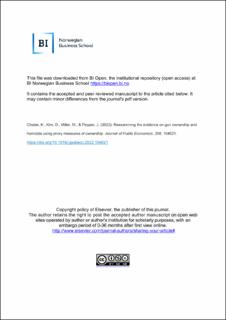Reexamining the evidence on gun ownership and homicide using proxy measures of ownership
Peer reviewed, Journal article
Accepted version
Permanent lenke
https://hdl.handle.net/11250/2983393Utgivelsesdato
2022Metadata
Vis full innførselSamlinger
- Scientific articles [2181]
Originalversjon
Journal of Public Economics. 2022, Volume 208, April 2022, 104621 10.1016/j.jpubeco.2022.104621Sammendrag
Limited by the lack of data on gun ownership in the United States, ecological research linking firearms ownership rates to homicide often relies on proxy measures of ownership. Although the variable of interest is the gun ownership rate, not the proxy, the existing research does not formally account for the fact that the proxy is an error-ridden measure of the ownership rate. In this paper, we reexamine the ecological association between state-level gun ownership rates and homicide explicitly accounting for the measurement error in the proxy measure of ownership. To do this, we apply the results in Chalak and Kim (2020) to provide informative bounds on the mean association between rates of homicide and firearms ownership. In this setting, the estimated lower bound on the magnitude of the association corresponds to the conventional linear regression model estimate whereas the upper bound depends on prior information about the measurement error process. Our preferred model yields an upper bound on the gun homicide elasticity that is nearly three times larger than the fixed effects regression estimates that do not account for measurement error. Moreover, we consider three point-identified models that rely on earlier validation studies and on instrumental variables respectively, and find that the gun homicide elasticity nearly equals this upper bound. Thus, our results suggest that the association between gun homicide and ownership rates is substantially larger than found in the earlier literature.

